Welcome to our guide on how to buy a gold IRA. If you’re looking to diversify your retirement investment portfolio and take advantage of the potential benefits of precious metals, a gold IRA can be an excellent option. In this article, we’ll provide you with all the essential information you need to know about purchasing a gold IRA, from understanding the basics to exploring different types of gold IRAs and the associated risks. Let’s get started!
Key Takeaways:
- A gold IRA is a specialized retirement account that allows investors to hold physical gold as an investment.
- Gold IRAs require finding a specialty custodian or firm that can handle the necessary documentation and reporting.
- Understanding the different types of gold IRAs, such as traditional, Roth, and SEP IRAs, is essential.
- Investing in a gold IRA can provide diversification and act as a hedge against inflation.
- Funding a gold IRA can be done through rollovers, transfers, or cash contributions.
Understanding Gold IRAs
Gold IRAs offer investors the unique opportunity to diversify their individual retirement account (IRA) holdings by including physical gold, silver, platinum, or palladium as investments within their portfolio. Unlike traditional IRAs that primarily focus on stocks and mutual funds, gold IRAs provide a self-directed approach that allows individuals to allocate a portion of their retirement savings to precious metals.
A gold IRA requires the use of a custodian, typically a trusted bank or brokerage firm, to manage the account on behalf of the investor. This ensures compliance with IRS regulations and provides a secure storage solution for the physical assets. The custodian will handle all administrative tasks, such as reporting and documentation, so investors can enjoy the benefits of owning precious metals without the hassle of managing the logistics themselves.
In addition to physical gold, investors can explore gold-related paper investments within their gold IRA. This includes exchange-traded funds (ETFs) that track the price of gold, gold mining stocks, or mutual funds focused on precious metals. These options allow for greater flexibility in portfolio management and enable investors to participate in the gold market without directly owning physical bullion.
The inclusion of gold in an IRA is often seen as a strategic move to hedge against inflation and protect against market volatility. Gold has historically retained its value over time and has served as a reliable store of wealth. By diversifying their retirement portfolio with gold, investors can reduce their exposure to traditional assets and minimize the impact of economic uncertainty.

Setting Up a Gold IRA
Setting up a gold IRA is a straightforward process that requires finding a specialty custodian or firm that offers this type of account. At our firm, we specialize in helping investors set up gold IRAs and navigate the intricacies of this unique investment vehicle.
The first step is to open a gold IRA account, which can be done through a custodian or broker that offers this service. We recommend conducting thorough research to find a reputable and experienced custodian that meets your specific needs.
Once you have chosen a custodian, they will assist you in completing the necessary documentation and provide guidance throughout the process. It’s important to note that the rules for contribution limits and distributions in a gold IRA are the same as traditional IRAs.
The contribution limits are set by the IRS and vary depending on the age of the account holder. For individuals under the age of 50, the maximum annual contribution is $6,000, while those aged 50 and above can contribute up to $7,000 per year. These limits are subject to change, so it’s important to stay informed about any updates or adjustments.
When it comes to distributions, it’s crucial to understand that early withdrawals from a gold IRA may incur penalties. The IRS imposes a 10% penalty on withdrawals made before the age of 59 ½, unless the distribution qualifies for an exception.
In addition to contribution limits and distributions, another important consideration when setting up a gold IRA is storage. Physical gold held in a gold IRA must be stored in an IRS-approved facility and cannot be stored at home. These facilities provide secure storage for precious metals, ensuring their safety and compliance with IRS regulations.
At our firm, we can guide you through the process of setting up a gold IRA and provide you with the necessary resources and expertise to make informed investment decisions. Our team is dedicated to helping you achieve your retirement goals and maximize the potential benefits of a gold IRA.
Types of Gold IRAs
The Different Forms of Gold IRAs
When it comes to investing in a gold IRA, there are various options available to suit different financial goals and circumstances. Three common types of gold IRAs include:
- Traditional Gold IRA: This type of IRA is funded with pretax dollars, meaning that contributions can be made before taxes are deducted from your income. However, withdrawals from a traditional gold IRA are taxed at retirement.
- Roth Gold IRA: With a Roth gold IRA, contributions are made with after-tax dollars. The advantage of this type of IRA is that withdrawals at retirement are tax-free. It offers tax advantages to individuals who expect to be in a higher tax bracket during retirement.
- SEP Gold IRA: SEP gold IRAs are specifically designed for individuals who are self-employed or work for small businesses. They have specific contribution limits and can provide tax advantages for business owners and their employees.
Each type of gold IRA offers its own benefits and considerations. It’s essential to carefully evaluate your financial situation and consult with a financial advisor to determine which type of gold IRA aligns best with your long-term investment goals.

Risks of Gold IRAs
Investing in a gold IRA can be a lucrative option for diversifying your retirement portfolio, but it’s essential to be aware of the risks involved. Understanding these risks will help you make informed decisions and protect your investments.
Volatility in Gold Prices
One of the primary risks associated with gold IRAs is the volatility of gold prices. The price of gold can fluctuate significantly in response to various economic factors and market conditions. While gold is often considered a safe haven investment, it does not guarantee high returns. It’s crucial to assess your risk tolerance and evaluate how fluctuations in gold prices may impact your investment strategy.
Higher Fees
Compared to traditional IRAs, gold IRAs typically come with higher fees. These fees can include custodial fees, storage fees, and transaction fees. It’s important to carefully review and compare these costs to ensure they align with your financial goals and investment priorities. Understanding the fee structure associated with your gold IRA will help you make informed decisions and optimize your returns.
Storage Risks and Custodian Fraud
When investing in physical gold for your IRA, there is a risk associated with storing and safeguarding the precious metal. Gold must be held in an IRS-approved storage facility, adding an extra layer of complexity and potential vulnerability. Additionally, there is a risk of fraudulent custodians who may mismanage or disappear with your assets. Conduct thorough research and due diligence when selecting a reputable custodian to mitigate these risks.

Assessing your own financial situation and investment profile is crucial before deciding to invest in a gold IRA. Understanding these risks in conjunction with your investment goals and risk tolerance will help you determine whether a gold IRA aligns with your retirement strategy.
Buying Gold in an IRA: Self-Directed Gold IRA
One way to buy gold in an IRA is to open a self-directed gold IRA. This type of IRA allows investors to diversify their portfolios by investing in certain precious metals, real estate, and other alternative assets. With a self-directed gold IRA, you have more control over your investment choices compared to traditional IRAs that only allow for stocks and mutual funds.
When setting up a self-directed gold IRA, it is important to choose a custodian approved by the IRS. The custodian will handle the paperwork and ensure compliance with IRS regulations. They will also help you select and purchase gold that meets the IRS standards for inclusion in your IRA.
After purchasing the gold, it needs to be stored in an IRS-approved depository for safekeeping. These depositories are highly secure and provide a controlled environment to protect your investment. Storing the gold in an approved depository ensures its eligibility within your self-directed gold IRA.
It is essential to carefully consider the fees associated with self-directed gold IRAs. While this type of investment offers flexibility and potential diversification, there may be higher fees involved compared to traditional IRAs. Take the time to review and compare custodian fees and any other associated costs to ensure that they align with your investment goals.
Investing in a self-directed gold IRA can be a strategic move to add stability and diversity to your retirement portfolio. It allows you to tap into the potential of precious metals and alternative assets as part of your long-term investment strategy.

Exploring Alternative Assets
Investing in a self-directed gold IRA is just one way to explore alternative assets. There are several other options available, such as real estate, cryptocurrencies, and private equity. These alternative assets can provide additional avenues for diversification and potential growth.
Consulting with a Financial Advisor
To ensure that you make informed investment decisions, it is always advisable to consult with a financial advisor. They can guide you through the process of setting up a self-directed gold IRA and provide personalized advice based on your financial goals and risk tolerance.
Buying Gold in an IRA: Use Existing IRA
Looking to buy gold in an IRA? Consider utilizing your existing IRA, such as a traditional or Roth IRA, to diversify your investment portfolio. While direct purchase of physical gold is not possible, there are alternative options to gain exposure to gold within your IRA.
Investors can allocate their IRA funds into gold-related investments. This includes gold-focused mutual funds, gold futures, gold ETFs, or gold mining stocks. By investing in these gold securities, you can participate in the potential benefits of gold without the need to physically own and store the metal.
Gold-focused mutual funds allow investors to pool their money with other shareholders to invest in a diversified portfolio of gold-related assets. Gold futures contracts provide an opportunity to profit from the price movements of gold without owning the physical metal. Gold ETFs offer an easy and convenient way to invest in gold as they track the performance of gold bullion.
Investing in gold mining stocks provides exposure to companies involved in the exploration, production, and sale of gold. These stocks are influenced by both the price of gold and the operational performance of the mining companies.
It’s important to research and analyze these gold-related investment options within an IRA. Consider factors such as expense ratios, historical performance, and the level of risk associated with each investment. Consulting with a financial advisor can provide valuable insights and guidance tailored to your individual investment goals.
Benefits of Gold IRAs
Investing in a gold IRA offers numerous benefits and can be a prudent strategy to protect your retirement savings. Gold is widely recognized as a hedge against inflation, making it an attractive investment during periods of economic uncertainty and stock market volatility.
One of the key advantages of a gold IRA is its ability to help diversify your investment portfolio. By adding gold, you can reduce the overall risk of your portfolio and potentially enhance returns. Gold has historically had a low correlation with other asset classes, such as stocks and bonds, which means that it can perform independently and provide a valuable buffer when other investments are underperforming.
Unlike stocks or paper assets, gold is a tangible asset that you can physically hold. This intrinsic value and the historical stability of gold make it an excellent store of wealth. With a gold IRA, you have the opportunity to safeguard a portion of your retirement savings in the form of precious metals, which can provide stability and peace of mind.
Moreover, gold has a long history of maintaining its value over time. Throughout economic downturns and crises, gold has proven to be a reliable asset, preserving investors’ purchasing power. By including gold in your retirement portfolio, you can potentially protect your wealth from the erosive effects of inflation and ensure that your savings retain value over the long term.
In summary, a gold IRA offers the benefits of diversification, a hedge against inflation, and the potential for long-term wealth preservation. By exploring this investment option, you can take advantage of the unique characteristics and historical performance of gold to secure your financial future.
How to Fund a Gold IRA
When it comes to funding a gold IRA, there are several options available to investors. One popular method is to rollover funds from an existing retirement account into a gold IRA. This allows individuals to transfer money from a 401(k), 403(b), or other retirement plan and invest it in precious metals such as gold. Rollovers must be done correctly to avoid penalties or taxes, so it’s important to consult with a financial advisor or IRA custodian to ensure a smooth transfer.
Another way to fund a gold IRA is to transfer funds from another IRA. Individuals can consolidate their retirement accounts by moving the funds from a traditional IRA, Roth IRA, or SEP IRA into a gold IRA. This transfer allows for greater control and diversification of investments within the IRA. Again, it’s crucial to follow the proper procedures to avoid any tax implications or penalties.
Lastly, individuals can also contribute cash directly to a gold IRA. This is a straightforward method where investors can make regular contributions just like they would with a traditional or Roth IRA. By contributing cash, investors have the flexibility to increase their holdings of gold within the IRA over time.
When deciding how much to fund a gold IRA, it’s essential to consider overall portfolio diversification and financial goals. A financial advisor can provide guidance on the right amount to invest in gold based on individual circumstances. Whether it’s through a rollover, transfer, or cash contribution, funding a gold IRA can be a strategic move to protect and grow retirement assets.
Image for illustrative purposes:
Conclusion
In summary, investing in a gold IRA can be a smart strategy to diversify your retirement portfolio and protect against inflation. By holding physical gold, you’re adding a tangible asset to your investments, which can help provide stability during uncertain economic times. However, it’s crucial to fully understand the rules and regulations that come with gold IRAs, as well as the associated risks and fees.
Before making any decisions regarding a gold IRA, we highly recommend consulting with a financial advisor. They can assess your individual circumstances and help determine if a gold IRA is a suitable option for you. They can also guide you through the process of finding a reputable custodian and understanding the documentation and reporting requirements.
To ensure a successful gold IRA, it’s important to stay informed and regularly review your investment strategy. Monitor the performance of your gold holdings and assess their impact on your overall portfolio. With the right guidance and careful consideration, a gold IRA can be a valuable addition to your retirement savings.
FAQ
How do I buy a gold IRA?
To buy a gold IRA, you can either open a self-directed gold IRA or use an existing IRA to invest in gold-related assets.
What is a gold IRA?
A gold IRA is a specialized individual retirement account that allows investors to hold physical gold or other precious metals as qualified retirement investments.
How do I set up a gold IRA?
To set up a gold IRA, you need to find a specialty custodian or firm that offers this type of account and can handle the necessary documentation and reporting.
What are the different types of gold IRAs?
The different types of gold IRAs include traditional gold IRAs, Roth gold IRAs, and SEP gold IRAs, each with specific funding and withdrawal characteristics.
What are the risks associated with gold IRAs?
Gold IRAs come with certain risks, including price volatility, higher fees compared to traditional IRAs, storage considerations, and potential fraud when selecting a custodian.
How can I buy gold in an IRA?
There are two ways to buy gold in an IRA. You can open a self-directed gold IRA and invest in physical gold or other approved assets, or use an existing IRA to invest in gold-related securities.
What are the benefits of investing in a gold IRA?
Investing in a gold IRA allows for diversification, acts as a hedge against inflation and economic uncertainty, and provides exposure to a tangible asset with a history of value maintenance.
How do I fund a gold IRA?
You can fund a gold IRA by rolling over funds from an existing retirement account, transferring funds from another IRA, or contributing cash based on your overall portfolio diversification and financial goals.
